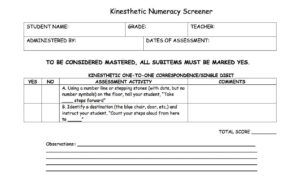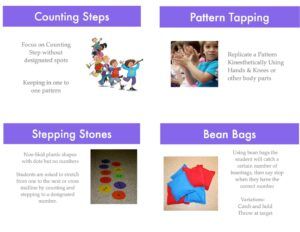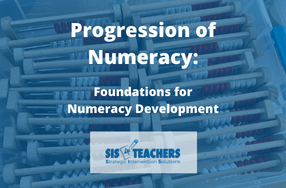When those sweet little faces arrive in kindergarten at the beginning of the year, they often don’t come with much background information.
 Since many of their students haven’t been in any kind of Pre K program, Kindergarten teachers are left wondering about the background of their students in the areas of reading and math, specifically numeracy development.
Since many of their students haven’t been in any kind of Pre K program, Kindergarten teachers are left wondering about the background of their students in the areas of reading and math, specifically numeracy development.
The hard part about assessing young children (in any subject!) so we can figure out what kind of experience and skills they have is that it can’t be done with a computerized test. Most young children have never held a mouse before because they are so used to touch screens, yet we put them on a computer to take an assessment by clicking on images. If a student struggles on a computerized assessment, it’s hard to tell if the student has a knowledge issue or just a physical skills issue. If a child is randomly clicking, how do we really get an accurate picture of their math skills at such a young age?
Many skills at the kindergarten level have to be assessed in a one-on-one setting, which is very lengthy. Part of the benefit of ESGI is that it makes it easier for teachers to be able to conduct those individual assessments (look for our numeracy screener on ESGI soon!).
The reality of trying to assess students one-to-one in a classroom setting is that, while you’re trying to look for what the student is doing and notice the things the screener is asking for, you also have 30 other monkeys in your classroom crawling around, being kids. For many kids, the kindergarten classroom is their first experience with a structured classroom, so I always joke that kindergarteners are probably running around licking each other and hiding under tables especially when they first start the school year. Trying to assess students at this age is really complicated in our schools.
In our M³ schools, to begin the year by collecting data with our numeracy screener in Kindergarten and 1st grade so we can get an idea of where our students are in numeracy. The screener asks a few questions and tells you so much about that student’s developmental progress. In reality, it nothing to do with assessing numbers or asking a child to identify if they see a certain numeral, it’s looking more at if they understand quantity and then how to play with it.
Step 1: Counting to 10
This first prerequisite as we’re looking at numeracy is to see if the child can count to 10. It’s almost impossible to assess kinesthetic one-to-one correspondence if a student can’t count one-to-one as well. We have many kids coming into Kinder that count “1, 2, 3, 5, 7.” That tells us that the oral language has not been developed in the home in which the child has grown up. Typically, when parents have not had conversations with their students, counting out different objects in real life.
Kids need to have thousands and thousands of experiences with real objects in the physical world to develop the understanding of counting and the rhythm of numbers. If students come into kindergarten with weak numeracy skills, we need to let parents know to help us in working with their students to be able to count to 10 rhythmically.
Step 2: Kinesthetic One-to-One Correspondence
The next area to look at is kinesthetic one-to-one correspondence (click here to read more about kinesthetic number sense). This week, when we were out in C.J. Sullivan Elementary in L’anse, MI, we were assessing their kindergarten students to see how many were at the kinesthetic level. Usually, we don’t assess an entire class, just the students that might be at risk. However, one of our kindergarten teachers felt that all her students were coming in so low that many of them would be on this level.
I was shocked as we were screening kids just how many couldn’t walk to a destination number 1-10, which is really the basis of our entire number system. The results of our Kinesthetic Numeracy Screener will help drive our instruction and give us a good idea of where kids are in one-to-one correspondence, which is a prerequisite for so many other skills. If we can’t walk and count with our body, we’re not going to be able to count objects and do other things.
Students are plugged in so often and screen time is such a dominant part of kids’ lives that they don’t have time to play with real objects in the physical world. (You can read more about that in our blog post about play in education.) Instead of more screens, kids need at least two hours of unstructured play every day. Given natural space and screen-free time, kids can develop this correspondence naturally. We do know that kids need to have thousands (yes, you read that right!) of experiences with rhythm and counting, so we need to provide time for that to happen. If they have that time, they’ll be doing things like hopscotch or jumping jacks outside or doing thing like riding a bike or paying four square and this is where where kids would start to develop that idea of one-to-one correspondence.
The Kinesthetic One-to-One Correspondence Screener
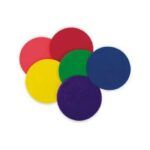
Assessing one-to-one correspondence is quick and easy. If you have a preschool or kindergarten round up, that is a great time to administer this quick assessment so teachers can see what students are bringing to the classroom. The assessment can be done with our poly spots, which are sold on our website in packs of 10. Each poly spot will display the numbers 1-10 in order to represent the numbers 1-10, but not in digit form. We want to display the numbers in in quantity form. For the numbers 1-5, I’ll typically use a dice pattern, and you could display 7-10 in a ten-frame pattern.
We want to refrain from putting the number symbol on the poly spots because it will skew the results of your screener. If you ask a child to walk to the 4, they might be able to do it because they can recognize and identify the symbol. That’s not really counting or cardinality. They’re not recognizing that the 4 is the fourth number in succession and that it comes after 3 and that 2 and 2 make 4, etc.
When you’re writing on the poly spots, make sure you’re using not just the Sharpie marker, but Sharpie paint marker. This will allow it to dry to the texture of the poly spots.
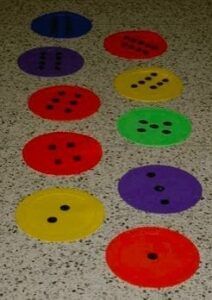
When they’re ready, line the poly spots up with about an adult’s foot width in between each spot. This line is a physical representation of our number system, the numbers 1-10. Kids need to know that, if they hop three spaces and then two more, they’re at 5. Our textbooks really seem to ignore this concept. They don’t take into account kids’ kinesthetic development and where they are with number sense.
Beginning the Screener
We want to make sure we have tape or a designated starting line where kids know to put their feet. Often, kids will automatically start counting with the number one, but if they’re moving their bodies and counting same time, when they get to the number two, they’ll be counting “one” movement. This will completely throw off their counting in the sequence. Instead, have the child stand at the front of the poly spots and ask them to walk to a certain spot, counting how many spots they are going.
It’s ok to model this for students. Say, “If I ask you to go to the number 5, it would look like this,” and either another teacher or yourself can demonstrate stepping on each poly spot in a walking manner while counting “1, 2, 3, 4, 5.” Then say, “Now it’s your turn. Show me how you walk to the number 4.”
As the students are completing this task, we’re watching for accurate correspondence in rhythm between counting and the number of steps. Some students do really well with numbers 1-5, but as they continue on numbers 6-10, they get off the count. Some students know where they want to land within the poly spots, what they’re saying doesn’t match up with where they actually are in the counting sequence.
In this video, this child did really well counting 1-5. But as she got going, she got mixed up and ended up on the number 9. She didn’t really understand the concept and you the know where she needs work.
Some kids, however, will be able to walk along the poly spots perfectly, almost like they think you’re crazy for asking them to do this! For these students, while they pass our short screener with one-to-one correspondence on their destination, we can do some further assessment to determine the limits of their correspondence by taking them off the poly spots.
Taking it Further
Ask a child to stand at a doorway and then walk to a specified destination across the room, counting his steps without the poly spots to guide them. Does the child still have the one-to-one correspondence necessary to make it from the door to the destination? Some kids will have the skill when there’s a well defined path, like the poly spots. But many students, when they start to walk at a normal pace, lose the one-to-one correspondence at that point.
When we’re observing this part of the assessment, some students start to walk like Frankenstein with each step kind of coming out awkwardly in front of the other. We don’t want that! We want them to walk fluidly. We might have to help them think about how they would walk to get to the bathroom or when it’s time to go out for recess. Then you can see which kids can easily associate counting with the physical movement so you can really understand where they are in their development of number sense.
Counting and Reading
 This level of kinesthetic one-to-one correspondence is similar to the level in reading where kids can either supply or identify a rhyme. Typically, kids can either rhyme or they can’t and if they can’t it will be pretty obvious. You can ask, “Do cat and hat rhyme?” and they’ll say yes or no. Or maybe you ask the child if they can supply a word that rhymes with cat and hat. If the child hasn’t developed this rhyming skill yet, they might look around and call out the name of whatever they see close by – a water bottle for example. They really have no idea what you’re asking.
This level of kinesthetic one-to-one correspondence is similar to the level in reading where kids can either supply or identify a rhyme. Typically, kids can either rhyme or they can’t and if they can’t it will be pretty obvious. You can ask, “Do cat and hat rhyme?” and they’ll say yes or no. Or maybe you ask the child if they can supply a word that rhymes with cat and hat. If the child hasn’t developed this rhyming skill yet, they might look around and call out the name of whatever they see close by – a water bottle for example. They really have no idea what you’re asking.
We can’t teach a student to rhyme. We can do lots of great songs, dances, and activities, but at the end of the day, the child has to be able to hear and supply the rhyme. The same thing applies to kinesthetic one-to-one correspondence. I can count with the child, I can walk with the child, I can skip with the child, but at the end of the day, that student has to associate their counting with their walking. As we have more and more “motor-ly awkward” kids coming in, this is really a prevalent issue.
Lack of kinesthetic number sense often goes unnoticed because we don’t take time to look at kids from a developmental perspective. Instead, we end up trying cram in the development of this foundation skill so we can get kids to be able to do things like add by the end of their kindergarten year. In fact, a whole layer of development is missing. In all honesty, you might be able to get a student to the point of being able to add without focusing too much time on kinesthetic number sense, but it would be an illusion. Later on, when the child is taking more advanced topics in math, the absence of that layer of kinesthetic one-to-one correspondence will start to be evident.
Think about this same idea in reading. I would never dream of teaching a child to read if they don’t have phonemic awareness or the precursor skills that are going to help them in reading. But why is it that in the US in math, we ignore those precursor skills in favor of cramming curriculum into their day without taking into consideration the developmental perspective. We sit kids in front of computers and assess them to the point where we might not be able to see the development of a child.
Building Kinesthetic Number Sense
As we complete our screener in our M³ initiative school, so many kids are often identified as needing to build the skill of kinesthetic one-to-one correspondence – maybe 15 out of two sections of a kindergarten class. There is good news though! All it takes to build kinesthetic one-to-one correspondence, in most cases, is about 10 minutes a day, for three weeks, of catching and throwing bean bags, walking on poly spots, and other simple activities. With this kind of dedicated, consistent practice, we’re seeing most kids developing the skill quite quickly.
It’s fun to do kinesthetic stations and centers where we can target the skills we need to.
 Mathematics Their Way is an oldie but goodie! Most schools have it available in their building. It’s filled with all kinds of activities that you can do to promote kinesthetic number sense with you students! All the Blackline Masters are online to go with the book! http://www.center.edu/
Mathematics Their Way is an oldie but goodie! Most schools have it available in their building. It’s filled with all kinds of activities that you can do to promote kinesthetic number sense with you students! All the Blackline Masters are online to go with the book! http://www.center.edu/

